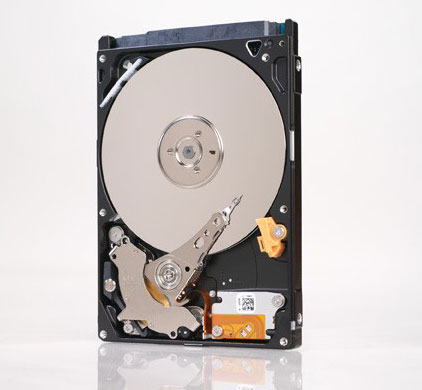Seagate's Momentus XT Reviewed, Finally a Good Hybrid HDD
by Anand Lal Shimpi on May 24, 2010 9:31 AM EST- Posted in
- Storage
- SSDs
- Seagate
- Momentus XT
- Hybrid Drive
- SSHDs
Final Words
Seagate's Momentus XT should become the standard hard drive in any notebook shipped. The biggest problem I have with using any brand new machine, regardless of how fast it is, is that it never feels fast because it usually has a HDD and not an SSD. While the Momentus XT isn't quite as fast as an SSD, it's a significant improvement over the mechanical drives found in notebooks today.
In many cases the Momentus XT performs like a VelociRaptor, but in a lower power, quieter package. The impact of adding just a small amount of SLC NAND is tremendous. I wonder what kept Western Digital from sticking some NAND on its VelociRaptor instead of giving us the lackluster upgrade we got earlier this year.
The potential for hybrid drives continues to be huge, what Seagate has shown here is that with a minimal amount of NAND you can achieve some tremendous performance gains. There's no reason for any performance oriented mechanical drive to ship without at least some small amount of NAND on board. There's also much room for Seagate to innovate. We could see drives with more NAND or truly hybrid drives that provide read and write caching in NAND.

Compared standard 2.5" drives, the Momentus XT will set you back an additional $50 - 90 depending on the capacity point. The added cost is absolutely worth it. It's still a lot cheaper than an SSD since we're in the sub-$0.31 per GB area while SSDs sell in the range of $2 - $4 per GB.
If you're not going to buy an SSD for your notebook, then definitely go for the Momentus XT. I'd almost go as far as to say it's a great option for desktop users but unless you're on a budget you're probably better served by a small SSD + 3.5" drive on the desktop.










120 Comments
View All Comments
enderwiggin21 - Tuesday, May 25, 2010 - link
Almost 40% more at idle and ~33% more at load is most definitely "considerably more."Under 10% and *then* you're into the statistically insignificant category.
svend - Monday, May 24, 2010 - link
Will the NAND still be effective when using the XT with an encrypted partition/filesystem? What affect would encryption have on the performance of the XT?GullLars - Monday, May 24, 2010 - link
Thumbs up to seagate for the sollution, the one used in previous hybrids that relied on the OS was not very effective.I actually made a thread on XS forum a couple of months back discussing a sollution like this, a HDD with a NAND read-only cache using LBA read pattern mapping as caching algorithm.
In my discussion, i suggested using 8-16GB (1-2 dual plane dies) MLC ONFI 2.x NAND on a single channel for lower complexity. This would give up to about 7500 4KB random read IOPS (30MB/s), and 90-180MB/s sequential read (for cache hits). At a cost of roughly 2-3$/GB + a NAND controller, the added price tag would be around 25-50$.
I think this could be interresting for higher capacity 3,5" "black" drives as well as high-performance high capacity notebook HDDs.
auhgnist - Monday, May 24, 2010 - link
Hybrid HD seems similar to Intel Turbo Boost technology, in terms of both SSD capacity and NAND type, except that Turbo Boost allows certain level of control such as caching only data accessed some pre-given programs. Any idea how these two compare in terms of performance?joshv - Monday, May 24, 2010 - link
I mean seriously. Add another 4GB of RAM and let the OS do the caching. Sure, it won't help with boot, but for everything else it should be a lot faster than some SLC NAND on the HD.enderwiggin21 - Tuesday, May 25, 2010 - link
Or how about both?mpx999 - Monday, May 24, 2010 - link
It would be interesting to compare performance of hybrid SSD with software-based flash read cache schemes. There are basically two of them for Windows: built-in Readyboost and third-party eBoostr. Other operating systems have even better mechanisms, eg. Solaris has L2ARC caching scheme for reads and ZIL for writes.http://blogs.sun.com/brendan/entry/test
http://dotnet.agilekiwi.com/blog/2008/10/how-eboos...
Both Windows caching mechanisms can work with either USB sticks, or memory cards in built-in readers. Second option is very interesting as it means SLC flash cards can be used.
I suspect hardware controlled read-cache as implemented in this hybrid drive will totally beat Windows software -based mechanism in one important application: running virtual machines. It's because hardware cache operates on disk blocks so it doesn't matter it these blocks are from base machine or virtual machine, while software Windows mechanisms rely on file-based statistics, so they only speed up base machine. One would have to create separate cache for each VM to get speedup. Btw. software-based Solaris caching doesn't have this limitation.
vision33r - Monday, May 24, 2010 - link
It's nowhere need a true SSD in performance and just offers the cheap space of a spindle drive.The the same has having a SSD internally and carrying a spindle drive externally.
Once SSDs gets cheaper, solution like this will be less interesting.
I expect SSD prices to drop from $99 for a 40GB to like $60, then we'll see 200GB SSD for like $150 or less.
jmv2009 - Monday, May 24, 2010 - link
I don't think writing through the ssd is that important, as it can be effectively cached using the main memory of the system. Only for sustained writes >1 Gb this would become slow if the caching works well.nsravan - Monday, May 24, 2010 - link
The site had not much activity since you went on vacation. So I took one too :)